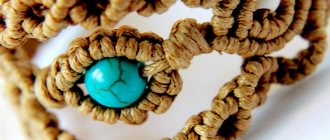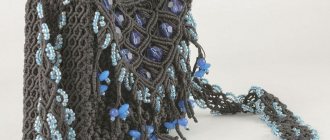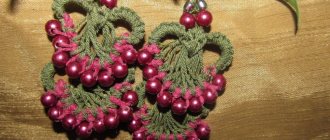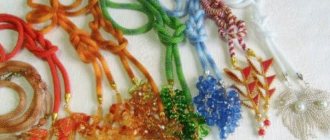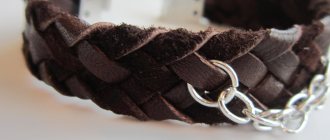Flat knot
These are the very first and simplest knots in this technique. Flat nodules can be right-sided or left-sided.
To weave a left-hand one, you need to take the left working thread and bend it to the right, on top of the rest. Then take the right working rope and place it on top of the left one. Bring it under the rest of the threads and pull it into the created loop.
The right flat knot should be woven in the same way, only in a mirror image. You need to weave from right to left.
LiveInternetLiveInternet
Quote from message Baikalochka_10
Read in full In your quotation book or community!
Flat macrame knots (MK video)
Macrame knots. Flat knots . Types of flat knots, methods of weaving them and patterns from them.
With video tutorials
Let's learn how to weave the first flat knot.
Photo 1.
Strengthen 2 threads to the base (red thread in photo 1). It turned out to be 4 ends (threads). Distribute the threads, counting them from left to right: threads 1 and 4 are working, and 2 and 3 are the warp. When weaving, we are dealing with two types of warps: a warp for attaching threads (red thread) and a warp for tying knots (threads 2 and 3).
So, to weave the first flat knot, take the right working thread with your right hand and bring it over the warp and under the left working thread. Now, with your left hand, take the left working thread and bring it under the warp and from below into the loop formed between the warp and the right working thread. This is the first flat knot (top of the knot in photo 1).
Based on this knot, you can weave a left-handed twisted chain. Continuing to work on the pattern you started, tie the first 3 more flat knots. The group of nodules turned slightly to the left. Turn the pattern 180° to the left and weave the first 4 flat knots, then turn the work 180° to the left again and tie the first 4 flat knots again. This will give you a left-hand twisted chain.
The second flat knot (the lower part of the knot in photo 1)..
Reinforce with 2 threads. With your right hand, take the right working thread and bring it under the warp and over the left working thread. With your left hand, take the left working thread, place it on the warp and insert it from above into the loop formed between the warp and the right working thread. This is the second flat knot.
Based on this knot, you can weave a right-handed twisted chain in the same way as a left-handed one.
If you tie the first flat knot, and immediately below it the second flat knot, you will get a double flat knot, or a square knot. A sign of completeness of the double flat knot is the lock on the right (photo 1).
However, the lock can also be obtained on the left if you tie the second flat knot first, and then the first. If you alternate the first and second flat knots, you get a chain of double flat knots. The number of nodes in the chain can be counted by the locks.
Macrame knots. Flat knots. Part 1.
Macrame knots. Flat knots. Part 2.
Macrame knots. Flat knots . Part 3.
Now look how, based on a track of double flat knots, the “Berry” pattern is made, which is very often found in macrame products:
Chess, or a grid of double flat knots.
Double flat knots tied in a checkerboard pattern are called checkerboard knots.
To weave a checkerboard pattern, weave 3 double flat knots in the first row. In the second row, leave the first two threads, and on the next four (2 from the first knot and 2 from the second) tie a double flat knot. There is another one nearby. The last 2 threads will remain unknitted. In the third row we repeat the pattern of the 1st row, in the fourth - the second.
Macrame knots. Chess.
https://yutnii-dom.ru/ochymelie-rychki/makrame/uzly-makrame-ploskie-uzly#more-345
Square or double flat
This unit is the basis of many products. It consists of two elements : a right-sided flat knot and a left-sided flat knot. The photo shows the weaving order.
Numbers 1 through 5 show a flat right-handed knot. From 6 to 8 – left-handed. When they intertwine, a square knot is formed.
This is what several square knots interconnected by a chain look like:
Rep look
This is one of the most popular knots in macrame.
Using these knots, horizontal, vertical and diagonal bridles are woven. This is the name given to rows consisting of rep knots.
Horizontal brids. Attach as many working threads as you like to the base. The outermost thread on the left should be especially long, as it will be the main thread. You don’t have to cut it off from the ball at all. The remaining ropes should be 4.5 times longer than the future product.
The thread on the far left must be pulled horizontally to the right above the other threads and secured with a pin. From the next thread on the left, 2 one-sided loops are made on the base. Then it is pulled tight and the working thread is left hanging vertically. Take the next thread and repeat the weaving - you get a horizontal bridle.
Related article: Pillows made from old jeans: from simple to original
After weaving the knots with all the working threads, the warp is turned to the left, horizontally. With your right hand you weave a horizontal brid from right to left.
At the turning point, secure the thread with a pin, otherwise it will come out sloppy.
Diagonal bridges. These knots are very popular in macrame style. You can use them to weave crosses, diamonds, circles, flowers, petals.
Pull the right thread at an angle down and to the left, above the other threads. Throw in 2 single-sided knots with each working thread. You just need to secure the thread with a pin in the upper right corner.
In brids that are woven to the right, you need to pull the leftmost thread down and to the right.
If you weave 2 brides close together, then for each next one you need to take the outermost rope and pull it near the previous one.
It is possible to start from the center and weave diamonds - first the left side, then the right.
Vertical brids. Here we get a tight weave. Typically used for weaving rugs, belts and other products that require tight knitting. The thread on which others are hung is the working one. There is no need to cut it off from the ball. The remaining threads are the warp and their length is the basis of the finished product.
You should start from the top right corner. Secure the threads with a pin. With your right hand, pull the first warp rope and weave two one-sided knots onto it. Continue the row to the end. Unfold the working rope to the right and secure with a pin. Pull the warp threads with your left hand, and with your right hand weave one-sided knots with a working rope. Continue to the end of the row. And so on.
This is what the main knots for beginners look like in macrame.
A little history
When mastering the ABCs of macrame weaving for beginners, you should familiarize yourself with the history of the original art. Its roots go back centuries, taking us to the shores of the mysterious East. The name is of Arabic origin, which means “braid, fringe, lace.” According to historical data, unusual needlework appeared in Europe in the 7th century. It is believed that such art was known in Ancient Egypt, Iran and China. The secret writings of the ancient Incas were very reminiscent of modern macrame. With the help of skillfully tied knots, they conveyed important information. Scientists are still puzzling over the mystery of the knotted writing of the Incas. The first reliable artifact that clearly tells contemporaries about the existence of unusual creativity is the painting by the talented Botticelli “The Adoration of the Magi,” where one of the characters in the canvas is wearing a cap woven in a similar way.
Botticelli's famous painting "The Adoration of the Magi"
The art is a knot knitting technique. Having mastered the basics of the simplest macrame patterns for beginners, you can weave macrame in the form of bracelets, fashion accessories, tablecloths, clothing items and even interior design.
A new era of crafts began in the 19th century, and technology acquired new features. It was at this time that art finally received its name. Samples of products from that time are of particular value today and are kept in museums dedicated to the history of needlework. In the 20th century, the peak of popularity came again, handicrafts became fashionable, thematic leisure clubs were created, where craftswomen mastered new weaving patterns, shared their experiences, and told those interested how to weave all kinds of jewelry. Many people have associations with Soviet wicker owls and flower pots. Today, macrame is taking on unusual forms; craftsmen are actively searching for new design solutions, creating masterpieces of amazing beauty and sophistication.
A little about macrame
